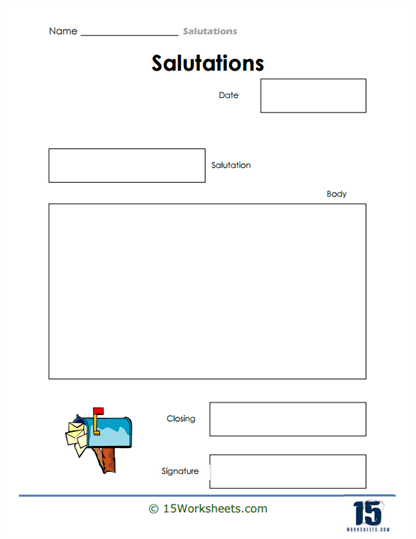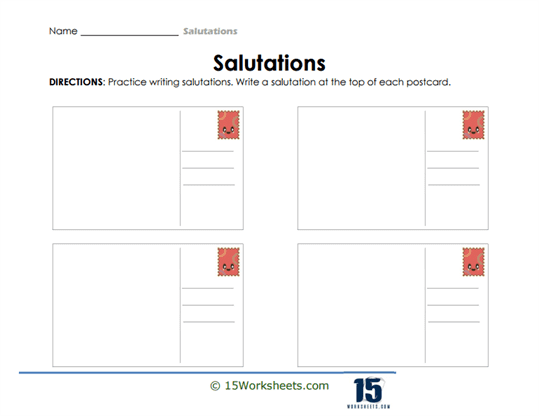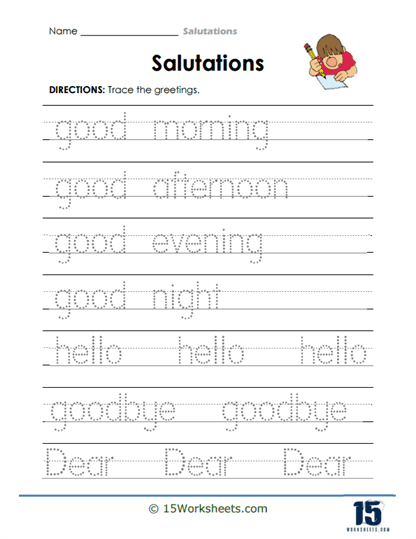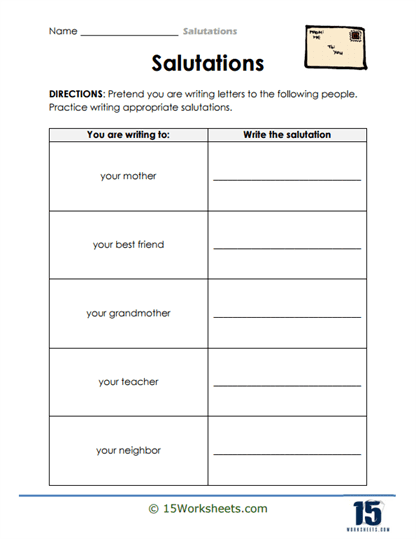Salutations Worksheets
About These 15 Worksheets
This series of worksheets offers a comprehensive range of engaging activities designed to teach students about the various ways to greet people in both formal and informal settings. This collection, ideal for teachers, homeschoolers, and students, covers everything from basic introductions to more complex situations where the correct salutation is essential. The worksheets are available in PDF format, ensuring they are easy to view, download, and print, making them an excellent resource for classroom and home use.
In this collection, students will find activities that introduce them to the differences between formal and informal salutations. For example, the worksheets provide tables with examples such as “Dear Sir” for formal occasions and “Hi” for informal greetings, helping students understand when to use each type of salutation. Through various exercises, learners are encouraged to practice these salutations by writing them out in different contexts, such as addressing teachers, friends, and sports coaches. This hands-on approach ensures that students not only learn the correct greetings but also understand the appropriate context for each.
One of the standout features of this collection is its focus on matching salutations to specific recipients or times of the day. For instance, students might be asked to match “Good Morning” with an image of a sunrise or to pair “Dear Mr. Smith” with a picture of a businessperson. These matching exercises are visually engaging and help reinforce the concepts in a fun, interactive way.
The collection includes cut-and-paste activities where students physically move salutations to the correct recipient. This tactile approach is particularly beneficial for younger students, who may benefit from the kinesthetic learning experience. They are encouraged to think critically about which greeting fits each character or situation, enhancing their understanding and retention of the material.
There are also worksheets focused on recognizing the appropriate time of day for different greetings, such as “Good Night” or “Good Afternoon,” paired with corresponding images. This not only helps students understand the language but also teaches them about cultural norms related to greetings.
To further deepen students’ understanding, the collection includes exercises where they write their own salutations for various scenarios. For example, a worksheet might depict a student writing a letter to a teacher, and the student must decide on the appropriate salutation to use. This type of activity encourages students to apply what they have learned in a practical, real-world context, which is critical for language development.
The collection also features true or false questions that test students’ knowledge of the rules around salutations. These worksheets are designed to reinforce learning by challenging students to remember key facts and apply their knowledge correctly. For instance, they might need to determine whether “All salutations are formal” is true or false, encouraging them to recall and think critically about what they have learned.
The activities are varied to cater to different learning styles, ensuring that every student has the opportunity to engage with the material in a way that suits them best. For those who prefer writing, there are exercises that require students to compose salutations based on given scenarios. These tasks not only teach proper etiquette but also enhance writing skills by encouraging thoughtful communication.
The collection includes templates for writing formal business letters, which are particularly useful for older students preparing for real-world situations. These worksheets guide students through the process of composing a letter from start to finish, including choosing the correct salutation. This practical skill is invaluable as students move towards adulthood and begin to encounter more formal communication in their academic and professional lives.
By combining visual, written, and interactive elements, these worksheets ensure that students not only learn the correct salutations but also understand the importance of using them appropriately in various contexts. Whether in the classroom or at home, this collection provides the tools needed to build strong communication skills that will serve students well throughout their lives.
What Are Salutations?
Salutations are the greetings or acknowledgements used at the beginning of a letter, email, or other forms of written communication. They serve as a formal or informal way to address the recipient, setting the tone for the rest of the message. In both grammar and language, salutations are crucial because they help establish the relationship between the writer and the reader, conveying respect, familiarity, or formality depending on the situation.
In grammar, salutations are typically followed by a comma or a colon, depending on the level of formality and the style guide being used. For example, “Dear Mr. Smith,” is a common formal salutation in a business letter, while “Hi Sarah,” might be used in a more casual email. The choice of salutation often reflects the writer’s awareness of social norms and conventions, showing an understanding of the appropriate level of formality or informality based on the relationship with the recipient.
From a linguistic perspective, salutations play an important role in communication as they help to create a connection between the writer and the reader right from the start. They function as a social cue that prepares the reader for the message that follows, whether it’s a friendly note, a formal request, or a professional correspondence. The use of an appropriate salutation can make the reader feel respected and valued, while an inappropriate one might lead to misunderstandings or convey a lack of respect.
Salutations also serve the purpose of setting the context for the message. By choosing the right salutation, a writer can immediately convey their intentions and the nature of the communication. For example, starting an email with “Greetings,” might indicate a formal or official communication, while “Hey there!” suggests a more relaxed and informal tone. This initial choice of words is a powerful tool in guiding the reader’s expectations and ensuring that the message is received in the intended manner.















